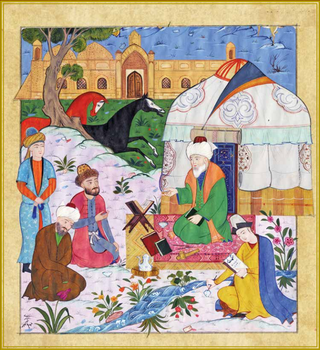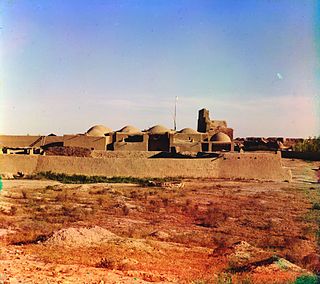
The Naqshbandi order is a Sufi order of Sunni Islam named after Baha al-Din Naqshband. They trace their silsila (chain) to Prophet Muhammad through the first caliph Abu Bakr by the way of Ja'far al-Sadiq. The Naqshbandi Sufi order is most distinguished from other Sunni schools by the high level of importance they assign to the sharia, highlighted by major Naqshbandi scholars such as Ahmad Sirhindi and Shah Waliullah Dehlawi.

The Qadiriyya or the Qadiri order is a Sufi mystic order (tariqa) founded by followers of Shaiykh Syed Abdul Qadir Gilani Al-Hassani, who was a Hanbali scholar from Gilan, Iran.

Ahmad Yasawi was a Turkic poet and Sufi, an early mystic who exerted a powerful influence on the development of Sufi orders throughout the Turkic-speaking world. Yasawi is the earliest known Turkic poet who composed poetry in Middle Turkic. He was a pioneer of popular mysticism, founded the first Turkic Sufi order, the Yasawiyya or Yeseviye, which very quickly spread over Turkic-speaking areas. He was a Hanafi scholar like his murshid, Yusuf Hamadani.

Abū Yaʿqūb Yūsuf al-Hamadānī, best simply known as Yusuf Hamadani, was a Persian Sufi of the Middle Ages. He was the first of the group of Central Asian Sufi teachers known simply as Khwajagan of the Naqshbandi order. His shrine is at Merv, Turkmenistan.

Baha' al-Din Naqshband was the eponymous founder of what would become one of the largest Sufi Sunni orders, the Naqshbandi.

Khwājagān is a Persian title for "the Masters". Khwajagan, as the plural for "Khwāja", is often used to refer to a network of Sufis in Central Asia from the 10th to the 16th century who are often incorporated into later Naqshbandi hierarchies, as well as other Sufi groups, such as the Yasaviyya. In Firdowsi's Shahnama the word is used many times for some rulers and heroes of ancient Iran as well. The special zikr of the Khwajagan is called 'Khatm Khajagan'.

The Eleven Naqshbandi principles or the "rules or secrets of the Naqshbandi", known in Persian as the kalimat-i qudsiya, are a system of principles and guidelines used as spiritual exercises, or to encourage certain preferred states of being, in the Naqshbandi Sufi order of Islamic mysticism.

Qadiriyya wa Naqshbandiyya is a Sufi order which is a synthesis of the Qadiri and Naqshbandi orders of Sufism. The Qadiriyya wa Naqshbandiyya Sufi order traces back through its chain of succession to Muhammad, through the Hanbali Islamic scholar Abdul Qadir Gilani and the Hanafi Islamic scholar Shah Baha al-Din Naqshband, combining both of their Sufi orders. The order has a major presence in three countries, namely Pakistan, India, and Indonesia.

Khwaja Haji Dost Muhammad Qandhari was an Afghan Sufi master in the Naqshbandi tradition in the 19th century (1801–1868).
The Naqshbandi-Haqqani Golden Chain is the chain of succession of Sufi masters in the Naqshbandi-Haqqani Sufi Order.

Ghawth SayyidMir Jan Shah Saheb ibn Hasan Naqshbandi Ishaani was a Sunni saint from Kabul and contemporary supreme leader of the Naqshbandi Tariqa and Naqshbandi Ishaani Sub-Tariqa as the 7th hereditary successor of his ancestor Hazrat Ishaan.

Hazrat Ishaan Mahmud bin Sharif bin Zia bin Muhammad bin Tajuddin bin Hussein bin Zahra binte Bahauddin Naqshband was an influential Sunni saint from Bukhara, Uzbekistan and hereditary supreme leader of his ancestor Bahauddin Naqshband's Sufi Order, the Naqshbandiyya.

Mir Sayyid Mahmud Agha, officially known as Sayyid ul Sadaat Mir Sayyid Mahmud Saheb Agha ibn Mir Hasan Naqshbandi al-Hasani wal-Husseini was a Sufi saint of South Asia. He was the brother of Sayyid Mir Jan and acted under him as Grand Master of the Naqshbandi Sufi order. Together with his brother, he preached the legacy of their ancestor Hazrat Ishaan.

Nāṣir ad-Dīn ʿUbaydullāh ibn Maḥmūd ibn Shihāb ad-Dīn more popularly known as Khwaja Ahrar was a member of the Golden Chain of the Naqshbandi Sufi spiritual order of Central Asia. He was born in Samarkand, a city in Central Asia, to a Muslim family. He was born to Khwaja Mehmood Shashi bin Khwaja Shihabuddin. His forefathers had migrated from Baghdad, and his lineage was connected to Abu Bakr Siddique from his paternal side and Umar Farooq from the maternal side. Khwaja Ahrar was deeply involved in the social, political and economics activities of Transoxania. He was born into a relatively poor yet highly spiritual family and, at the age of maturity, he was probably the richest person in the kingdom. He was a close associate of all the leading dervishes of the time. Maulana Abdur Rahman Jami was a disciple of his. He learned and practiced the secrets of spirituality under his father and later under Khwaja Yaqub Charkhi.

Sayyid ul-Sadaat Sayyid Moinuddin Hadi Naqshband al-Hasani wal-Husseini, known as "Hazrat Naqshband Saheb", was a Sunni Muslim wali (saint) from Bukhara and direct descendant of Muhammad, through his father Hazrat Ishaan who was a seventh generation descendant of Bahauddin Naqshband. Moinuddin Naqshband succeeded his father in leading the Silsile Aliyya Naqshbandiyya.
Sayyid Mir Fazlullah bin Sayyid Mir Hasan Naqshbandi was a Sunni Saint and Mir and the highest Qadi and Grand Mufti of the Emirate of Afghanistan.
Mir Sayyid Hasan ibn Azimullah was an Emir of a group of Sunni Sayyids of Khorasan, following the Sayyid ul Sadatiyya heritage. His descendants were confirmed as Emirs of the Afghan Sayyids and custodians of the Hazrat Ali Shrine by the Muhammadzai Royal Dynasty.

Khwaja Sayyid Mir Alauddin ibn Muhammad Attar, was a Sufi Saint from Bukhara and Qutb of the Naqshbandi Sufi order. He was a descendant of Muhammad and son in law of his master and predecessor Khwaja Bahauddin Naqshband.

Muhammad Zahid Vakhshi was a Sufi of the Naqshbandī Sufi order. He lived in Vakhsh, a small town in present-day Tajikistan, about 100 km South of the capital Dushanbe. Naqshbandī The Sufi order from Khwaja Ahrar transferred to him and he transferred to Darwish Muhammad. He was a close relative of Yaqub al-Charkhi, and according to some sources, he was his maternal grandson. His tomb is in Vakhsh.









